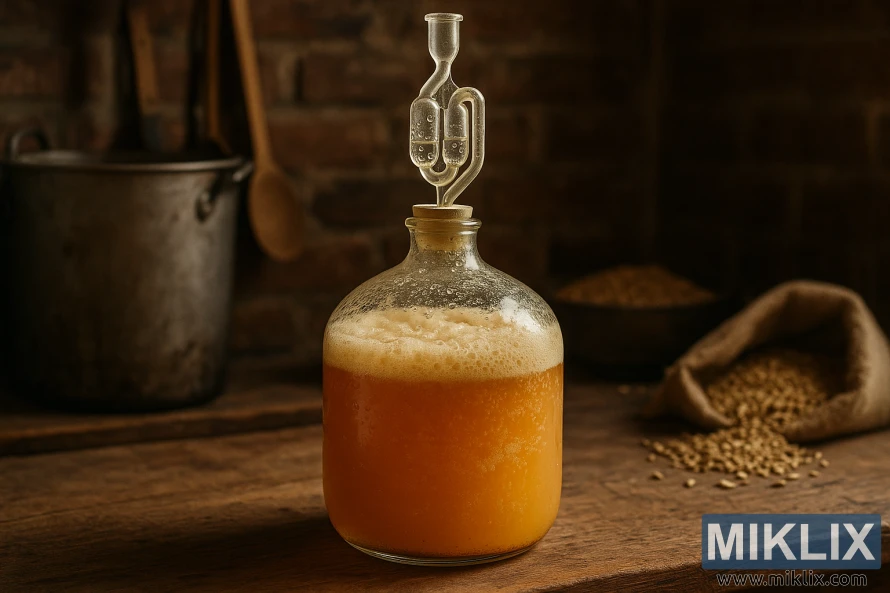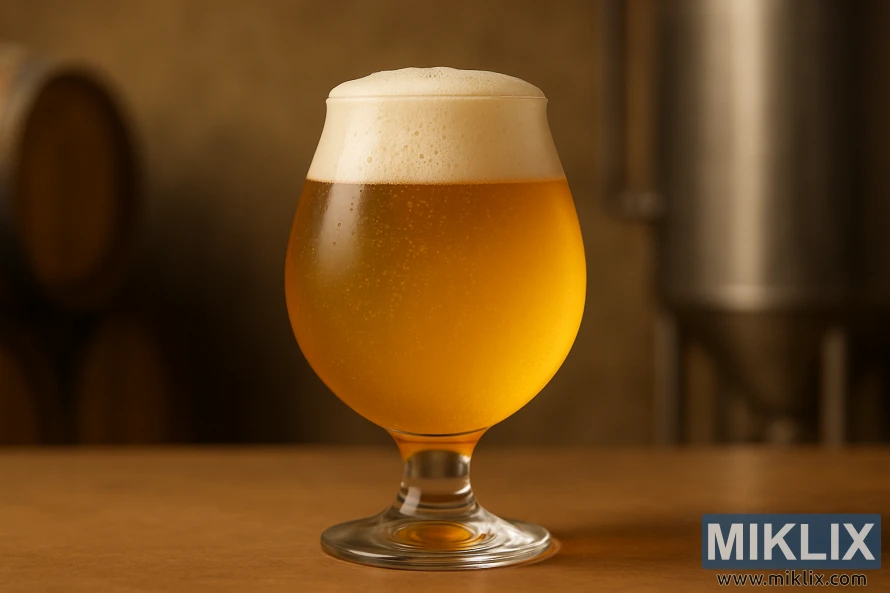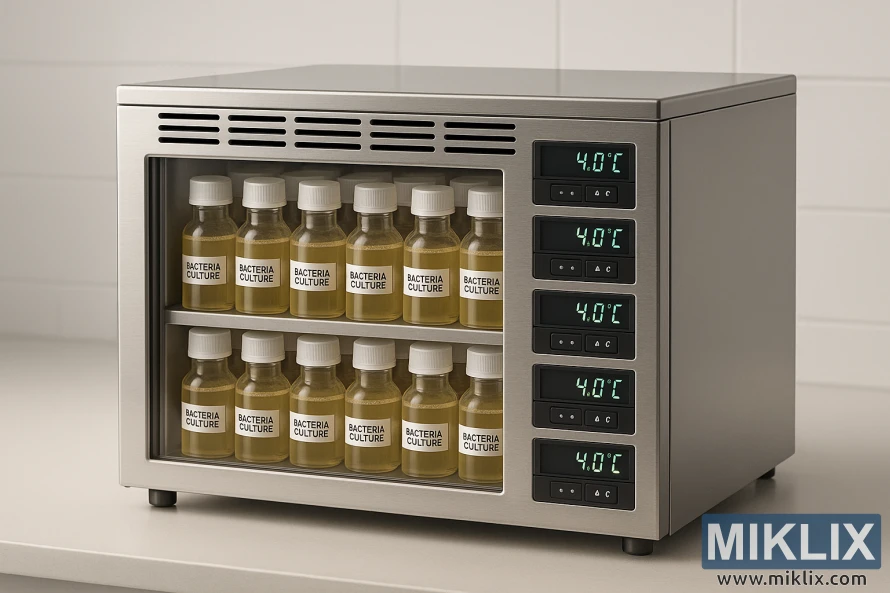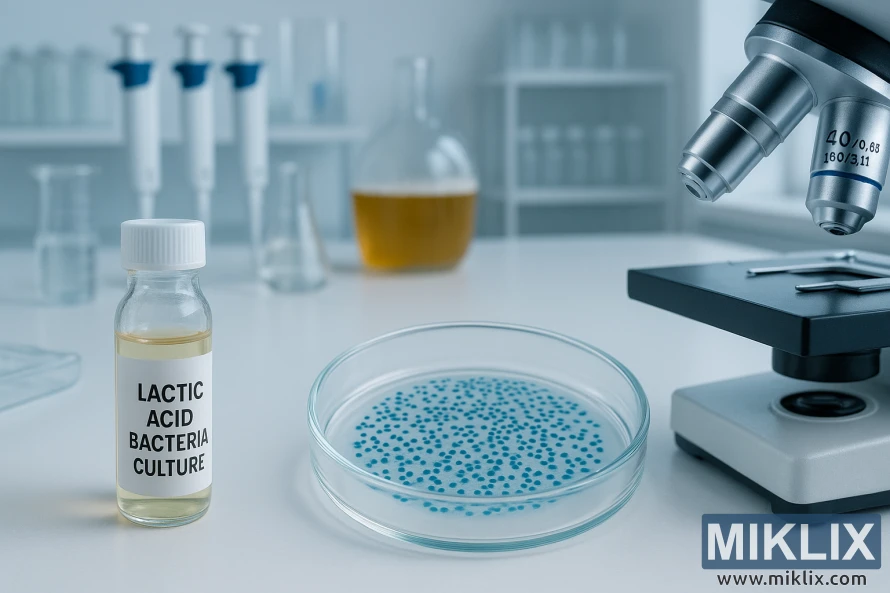Fermenting Beer with Fermentis SafSour LP 652 Bacteria
Published: September 15, 2025 at 7:14:16 PM UTC
SafSour LP 652™ is a dry lactic acid bacteria product from Fermentis, perfect for kettle souring. It uses Lactiplantibacillus plantarum, a lactic acid bacterium that turns wort sugars into lactic acid. This process has minimal byproducts, leading to rapid acidification and distinct flavors. The formulation boasts viable cells over 10^11 CFU/g, carried by maltodextrin. It comes in 100 g packaging and is E2U™ certified. This certification allows for direct pitching into non-hopped wort, streamlining sour beer fermentation for both home brewers and commercial brewhouses.

This review and guide will cover the technical details, pitching options, pH timelines, and sensory outcomes of SafSour LP 652. It aims to help brewers safely and reliably incorporate this product into their kettle souring routines.
Key Takeaways
- Fermentis SafSour LP 652 Bacteria is Lactiplantibacillus plantarum formulated for kettle souring.
- E2U™ certification permits direct pitching into non-hopped wort without rehydration.
- Packaging delivers >10^11 CFU/g in 100 g format for predictable souring performance.
- Sour beer fermentation with SafSour LP 652 typically produces tropical, citrus, and fruity notes.
- Guide covers dosing, temperature, pH targets, and practical kettle sour workflows.
Overview of Fermentis SafSour LP 652 Bacteria
Fermentis created SafSour LP 652 for controlled kettle souring. This overview covers its origin, biology, and use. It's designed for brewers seeking a dependable souring tool from Fermentis.
The culture is a homofermentative Lactiplantibacillus plantarum. It produces mainly lactic acid, with very low acetic acid. Brewers prefer this to achieve clean acidification and avoid vinegar notes in their beer.
Flavor aims include tropical, citrus, and fruity notes. These enhance the kettle-soured wort. They aim to brighten the beer without overpowering hop or malt flavors.
SafSour LP 652 has the E2U™ designation. This allows brewers to pitch it directly into cooled, non-hopped wort without rehydration. This simplifies the process and ensures consistency for both homebrewers and professionals.
The product is a dry preparation with a high viable cell count. It exceeds 1×10 CFU per gram. Quality specs show low contaminants, including strict limits for acetic bacteria, coliforms, wild yeast, and mold.
Fermentis bacteria for beer in this format are ideal for kettle souring. They are not suited for spontaneous or long-term barrel aging. The dry form and clear instructions make it accessible to craft brewers and hobbyists.
Use this SafSour LP 652 overview when planning recipes or souring schedules. It helps match flavor goals and process limits. The strain's predictable acid production and ease of use make kettle souring accessible in modern brewing.
How SafSour LP 652 Works in Kettle Souring
Kettle souring starts after boiling, when wort cools and hops are removed. This method avoids iso-alpha acid interference, allowing lactic bacteria to thrive. It gives brewers control over acidity before primary fermentation.
Fermentis SafSour LP 652 uses a homofermentative pathway for lactic fermentation. It converts wort sugars mainly into lactic acid, producing low levels of acetic acid. This process lowers pH and increases perceived acidity without the sharpness of vinegar.
The mechanism of SafSour LP 652 ensures consistent acid profiles with proper temperature and pitching rates. Faster pitching speeds can quickly reach the desired pH. Fermentis' sensory tests confirm that changing pitching rates affects speed, not flavor.
The strain's impact on taste is a mix of acidity and fruitiness. It produces tropical and citrus esters like mango, passionfruit, lemon, and grapefruit. These flavors enhance the beer's brightness and fruitiness, making it more vibrant and forward.
- Use non-hopped, cooled wort for effective kettle souring mechanism.
- Expect steady pH decline from lactic acid conversion with minimal acetic off-notes.
- Anticipate fruity esters that complement many sour styles in a Lactiplantibacillus plantarum kettle sour.
Recommended Dosage and Pitching Rates
Fermentis suggests a SafSour LP 652 dosage of 10 g/hL for standard kettle sours. This rate typically leads to lactic fermentation reaching desired acidity in 24–48 hours. Trials with a 12°P wort have shown this consistency.
Thanks to its E2U™ nature, brewers can directly pitch SafSour LP 652 into cooled, non-hopped wort. This method simplifies the kettle sour dosing process and cuts down handling time.
Increasing the dosage can accelerate acidification. Trials with up to 100 g/hL showed quicker pH drops and shorter souring periods. The primary variations were in time to acidity and final pH compared to the standard dosage.
Fermentis sensory panels detected minimal organoleptic differences between low and high dosing. The main distinction was in speed and pH. This means brewers can stick to the 10 g/hL pitching rate for consistent flavor. Adjusting the dose is then an option for those needing quicker results.
- Use pitching rate 10 g/hL for routine kettle souring and consistent results.
- Increase kettle sour dosing to reduce acidification time when schedules are tight.
- Pitch into cooled, non-hopped wort for best E2U™ performance.
Adjust SafSour LP 652 dosage based on wort density and recipe goals. Run small-scale trials before scaling changes to ensure the acidification timeline and final pH match your sensory targets.

Optimal Temperature and Fermentation Conditions
Temperature control is key for successful kettle souring with SafSour LP 652. Fermentis suggests pitching at 37°C (98.6°F). The strain can thrive between 30–40°C (86–104°F), with the best range being 37°C ±3°C.
For optimal results, set your kettle sour temperature close to 37°C. With a pitching rate of about 10 g/hL, you can expect the pH of an unhopped 12°P wort to reach your target in 24–36 hours. Increasing the pitching rate or the temperature can accelerate acid production.
The gravity of the wort also influences souring speed. Trials were conducted with a 12°P unhopped wort. Lighter worts will acidify quicker, while heavier worts may take longer. Adjust your expectations and monitor pH levels when working with different gravities.
Only use non-hopped wort during the souring phase. Iso-alpha acids from hops can inhibit growth, with half-max growth occurring around 5 ppm iso-alpha acids. Pitching into hopped wort will halt acidification and reduce efficiency.
Ensure consistent temperatures during souring and record them along with pH readings. Warm, controlled conditions are ideal for the thermotolerant Lactiplantibacillus plantarum, leading to predictable acid curves. If the temperature drops, acidification slows, and the target timeframe extends.
- Target: 37°C (98.6°F), acceptable 30–40°C (86–104°F).
- Pitching: 10 g/hL typical; adjust upward for faster results.
- Wort: use unhopped wort; gravity matters (12°P used in trials).
- Monitor: log kettle sour temperature and pH until desired acidity.
Target pH, Acidification Timeline, and Expected Results
Fermentis states that SafSour LP 652 pH typically reaches a final value within the range of target pH 3.2–3.6 under recommended conditions. Brewers using a 12°P baseline wort and following the supplier's dosing guidance can anticipate consistent acid levels within this range.
The acidification timeline varies based on dosage and temperature. At 10 g/hL and controlled temperature, it commonly takes 24–36 hours. Some trial data suggest a 24–48 hour window, while higher pitching rates or warmer conditions can shorten this time to reach the target pH 3.2–3.6.
Performance variables influence both final pH and speed. Pitching rate, wort gravity, temperature control, and oxygen exposure each play a role. Hotter fermentation and larger doses accelerate lactic production, moving the SafSour LP 652 pH downward more rapidly.
- Typical dosing: 10 g/hL yields 24–36 hour acidification in trials.
- Higher dosage: reduces acidification timeline and deepens acidity.
- Wort gravity: higher gravity slows acid production compared to 12°P.
As the beer approaches the target pH 3.2–3.6, perceived acidity and volatile acidity increase. Malt sweetness and malt-derived notes decrease. Fruit and citrus characters become more pronounced after lactic activity driven by SafSour LP 652.
Monitoring pH during the acidification timeline allows brewers to hit precise targets for balance. Regular checks help avoid over-acidification and guide decisions on when to cool, kettle-hop, or transfer to primary fermentation.
Sensory Profile and Flavor Contributions
Fermentis sensory work reveals a distinct SafSour LP 652 profile. It is characterized by bright, fruit-forward aromas. Trained tasters detected tropical citrus notes like mango, passionfruit, lemon, and grapefruit. These notes bring a lively character to the beer.
A panel of 40 trained assessors employed a 45-attribute protocol. They evaluated aroma, flavor, and mouthfeel. The results showed a significant increase in perceived acidity and volatile acidity after kettle souring. As acidity rose, perceived malt sweetness, including cereal and honey notes, decreased.
The fruitiness in kettle sours made with SafSour LP 652 remains consistent across different dosing levels. Tests comparing 10 g/hL and 100 g/hL showed faster acidification and lower final pH at higher doses. Yet, the same tropical citrus notes persisted in the aroma and flavor.
This profile is ideal for golden sour ales and fruited kettle sours. Brewers aiming for a clean lactic backbone and pronounced fruit character will find it suitable. SafSour LP 652 enhances fruit additions without overpowering them with heavy souring off-notes.

Compatibility with Hops, Yeast, and Brewing Process
When planning recipes, understanding SafSour LP 652 hops compatibility is essential. Iso-alpha acids from hops can hinder lactic acid bacteria growth. It's important to avoid hopping during the souring phase, as half of the inhibition occurs at around 5 ppm iso-alpha acids. To ensure proper acidification, SafSour LP 652 should be pitched into unhopped, cooled wort.
The kettle sour workflow must be carefully planned to allow acidification to complete before adding hops. Many brewers sour their beer, then pasteurize or boil it, and add hops for bittering and aroma. If boiling is skipped, the decision impacts both hop uptake and microbial control. The brewing process should align with the beer style.
Yeast compatibility is critical when transitioning from souring to primary fermentation. After souring and any heat treatment, Saccharomyces strains or specialty yeasts should be pitched. Fermentis advises conducting bench trials to confirm the yeast's performance in acidified wort and to achieve the desired flavors.
A simple kettle sour workflow involves creating non-hopped wort, cooling it to the recommended souring temperature, and pitching SafSour LP 652. Monitor the pH levels and decide whether to pasteurize or boil before hopping and primary fermentation. Each step influences hop expression and microbial control.
Hops added after souring will express differently in an acidic, low-pH wort. Expect enhanced hop aromatics and altered bitterness perception. For beers that emphasize hop flavor, time late additions to preserve volatile aromas and avoid adding hops during the souring window.
Strict sanitation and production separation are necessary to prevent contamination with non-sour batches. Running small-scale trials, following Fermentis handling guidelines, and documenting results are key. These steps enhance yeast compatibility and streamline the kettle sour workflow for consistent results.
Practical Kettle Souring Workflow with SafSour LP 652
To control acidity and flavor, follow a clear kettle souring workflow. Begin with standard wort production and a full boil. It's important to avoid late hop additions to prevent iso-alpha acids from affecting the souring process.
Utilize the SafSour LP 652 steps as a checklist during the souring phase. Cool the wort to the recommended souring range, near 37°C, or within 30–40°C, before pitching.
- Start by producing and boiling the wort normally, without adding hops late. Cool it to the souring temperature range before pitching any bacteria.
- Ensure the wort does not contain iso-alpha acids. Do not add hops before pitching SafSour LP 652.
- Pitch SafSour LP 652 directly into the cooled, non-hopped wort at 10 g/hL. Use E2U™ direct pitching; no rehydration is required.
- Maintain a temperature of 30–40°C, with optimal conditions near 37°C ±3°C. Keep the environment sanitary and limit oxygen exposure to prevent contamination.
- Monitor pH and time closely. Expect pH to reach about 3.2–3.6 within 24–36 hours at 10 g/hL. Adjust the dose upward if needed to shorten acidification time.
- After souring, choose to either heat/boil to kill bacteria, then add hops and ferment, or proceed with kettle sour workflows that retain bacteria with documented risk controls.
- Proceed with primary fermentation after souring and any heat treatment. Pitch a Saccharomyces brewing yeast and follow a standard fermentation schedule.
- Conduct pilot trials before full production to verify kinetics, sensory results, and integration into your process.
Keep accurate records of temperature, pH, and timing during each batch. This will help refine your kettle souring routine. Accurate logs are essential for reproducing desired acidity and flavor when scaling up.
Consistently apply the SafSour LP 652 steps to protect product quality and predictability. Small, repeatable adjustments ensure reliable outcomes across batches.
Storage, Shelf Life, and Handling Best Practices
For optimal storage, keep SafSour LP 652 packs in cool temperatures below 4°C (39.2°F). Ensure they are stored in dry conditions. It's essential to maintain a temperature of ≤4°C to keep the product viable and effective for kettle souring.
Fermentis technical documentation indicates a shelf life of 36 months from the production date. Retail listings might show shorter shelf lives. Always check the printed lot information on the sachet for the exact shelf life and expiration date before use.
- Packaging: 100 g sachets make handling and portioning simple for pilot and production batches.
- Transport: Ambient transit is possible, but avoid prolonged exposure above 30°C (86°F). Short peaks to 40°C (104°F) are allowed.
- Acceptable transit window: Up to 14 days at ≤30°C is generally acceptable for distribution.
When handling dry bacteria, follow standard brewery hygiene and sanitation practices. SafSour LP 652 is E2U™ and can be pitched directly. A small bench trial is wise before scaling to full production.
Maintain the cold chain whenever practicable. Variations in storage and transport conditions can reduce viability. Check printed expiration and viability claims on each sachet to confirm product fitness for your souring program.

Microbial Quality, Safety, and Product Specifications
Fermentis provides detailed specifications for SafSour LP 652, catering to both craft and commercial brewers. The packaging ensures viable cells of over 10^11 CFU/g at release. This supports rapid and consistent acidification in kettle souring trials.
Quality control measures are stringent, aiming to keep contamination within tight limits across all batches. The usual microbial contamination limits include total bacteria
The strain is homofermentative, mainly producing lactic acid with minimal acetic acid byproducts. This acid profile results in clean lactic acidity, reducing vinegar-like off-notes when used correctly.
It's important for brewers to consider hop interactions. SafSour LP 652 has a low tolerance to iso-alpha acids, with half-growth inhibition around 5 ppm iso-alpha acids. Adjust hop schedules and conduct small-scale trials to prevent reduced activity.
Sanitation and safety practices are essential to avoid cross-contamination in the brewhouse. Fermentis advises conducting fermentation trials before scaling up to commercial production. Following local food safety standards is also recommended to verify performance and safety.
- Viable count at packaging: viable cells >10^11 CFU/g.
- Accepted contamination limits as listed by quality control.
- Homofermentative lactic acid profile for clean souring.
Recipe Ideas and Styles Suited to SafSour LP 652
SafSour LP 652 excels in light, bright beers, where acidity and fresh fruit enhance the taste. Golden sour ales benefit from a crisp base, allowing citrus and tropical aromas to stand out. Berliner Weisse and Gose styles are ideal for a tart, low-body base that remains refreshing.
Fruit adjuncts like mango, passionfruit, and citrus fruits complement the strain's tropical and citrus notes. When creating fruited kettle sours, add fruit after souring to preserve aroma and limit oxidation. Dry fruit purées and fresh purées yield different results; select based on desired color and mouthfeel.
Adjust gravity and sugars to suit your recipe goals. Trials on 12°P wort show reliable acidification, but lighter worts sour faster. Heavier adjunct sugars can slow acid production. Adjust pitching rate and timing for high-sugar recipes to avoid under- or over-acidification.
Hopping strategy is critical because iso-alpha acids inhibit lactic bacteria. For classic kettle sour recipes, reserve most hops until after souring. You can reboil and add hops prior to primary fermentation for bitterness, or keep hopping cold-side for brighter hop character.
- Simple golden sour ales: Brew a low-color base, pitch SafSour LP 652 at 10 g/hL near 37°C, target pH 3.2–3.6, then ferment with a clean ale yeast.
- Fruited kettle sours: Sour to desired pH, cool, add fruit purée, then ferment with low-phenol yeast to preserve fruit aroma.
- Berliner Weisse variants: Use light malts, minimal hops, and produce a sharp, sessionable beer that highlights lactic tang.
- Gose-style adaptations: Add salt and coriander post-sour, balance mineral notes with fruit or citrus zest.
Example workflow for kettle sour recipes: produce a non-hopped wort, pitch SafSour LP 652 at 10 g/hL at roughly 37°C, monitor until pH reaches 3.2–3.6, then choose to reboil and add hops or proceed with cold-side fruit additions based on your risk tolerance. This sequence helps preserve desired aromatics while managing bacterial activity.
Comparing SafSour LP 652 to Other Lactic Bacteria Options
Brewers often compare SafSour LP 652 to traditional kettle-sour cultures when choosing a starter. This Lactobacillus plantarum vs other strains comparison reveals distinct trade-offs in flavor, speed, and handling. SafSour LP 652 stands out as a homofermentative bacteria, chosen for its high viability and reliable direct pitching.
Flavor is a key differentiator. SafSour LP 652 introduces tropical and citrus notes with minimal acetic acid. In contrast, other lactic strains may offer sharper tartness, more acetic character, or unique ester profiles. These are often preferred for mixed-fermentation ales or farmhouse styles.
Kinetics and thermotolerance distinguish performance. SafSour LP 652 tolerates temperatures between 30–40°C and sours relatively quickly. Some Lactobacillus and Pediococcus strains, on the other hand, sour more slowly or prefer cooler temperatures. This impacts scheduling in the brewhouse.
Hop tolerance is critical for hopped sour beers. SafSour LP 652 has low tolerance to iso-alpha acids (IC50 ~5 ppm), similar to many lactobacilli. Specialized brewing bacteria or adapted strains, though, can handle higher hop levels. They are ideal for mixed fermentations.
- Practical choice: compare SafSour LP 652 when you want predictable kettle souring with tropical/citrus character.
- Alternative use: choose other strains for farmhouse funk, complex acetic notes, or long barrel-age programs.
- Process fit: use SafSour LP 652 for direct-pitch convenience and consistent acidification.
When comparing Lactobacillus plantarum to other strains, consider flavor goals, temperature profile, and hop regime. This ensures you select the right lactic bacteria for your beer style and production workflow.

Troubleshooting Common Issues in Kettle Souring
Slow acidification can halt a brew day. Ensure the wort was free of hops before souring. Iso-alpha acids from late hopping can suppress lactic bacteria. Confirm the hopping timing.
Verify the pitched dose and its viability. Review storage history and expiration to confirm. Temperature is critical for reliable souring. SafSour LP 652 issues often stem from temperatures below 30°C.
Aim for temperatures near 37°C. Monitor pH and heat during the process. If acid curves lag, a measured increase in dose or a repeat batch at the correct temperature can restore pace.
Off-flavors signal contamination or process lapses. Excessive acetic notes rarely come from LP 652, as it is homofermentative. Suspect acetic bacteria or wild yeasts when vinegar or solvent aromas appear.
Tighten sanitation and cut oxygen exposure during souring to limit these risks. Hops-related inhibition shows as sudden stalls after additions. If you must hop, wait until target pH is reached or perform a post-sour boil.
This preserves acidity while killing bacteria. It avoids hops blocking lactobacillus and reduces the need for kettle sour troubleshooting later. Viability loss reduces fermentation power. If SafSour LP 652 issues appear after shipping or storage above 4°C, check cold chain records and lot shelf-life.
Consider running a small pilot test before scaling to a full batch when viability is in doubt. Unexpected off-flavors can come from cross-contamination or poor product handling. Use strict hygiene, dedicated souring vessels, and routine microbial limits testing.
Run trial sours when changing suppliers or altering the workflow to catch problems early. Use routine monitoring to stay ahead of problems. Track pH and temperature at set intervals.
If souring is behind schedule, raise temperature modestly or increase pitch in the next run. Stay within recommended bounds to protect flavor integrity.
- Check wort hopping and sanitation first.
- Confirm dose, viability, and cold-chain history.
- Keep souring temperature around 37°C when possible.
- Reduce oxygen exposure to prevent acetic contamination.
- Run pilot batches after any change in ingredients or handling.
Regulatory, Labeling, and Usage Notes for US Brewers
Fermentis provides technical and safety data sheets for SafSour LP 652. It's essential to keep these documents with batch records for traceability and quality control. Maintaining lot numbers, sachet use-by dates, and storage logs supports your HACCP plan.
For ingredient declarations, follow TTB and FDA guidance where applicable. Declare Lactiplantibacillus plantarum or a generic lactic acid bacteria term if required. Note any carrier such as maltodextrin when label law or voluntary transparency demands ingredient detail for labeling sour beer.
Record commercial trials before a wide release. Document process parameters, pH progression, sensory notes, and stability data. Such records support claims, lift quality assurance, and help with regulatory notes brewing bacteria during inspections.
- Retain SDS and technical data for each lot used.
- Log storage temperature and verify shelf-life on the sachet.
- Follow Fermentis recommendations for pilot-scale trials.
Import and distribution require attention to supplier documentation and cold-chain handling. Observe the stated storage temperature—keep product at or below 4°C—and use the shelf-life printed on the sachet. Some retail listings may show different shelf-life windows; rely on producer labeling for SafSour LP 652 US usage.
Integrate SafSour LP 652 into your brewery's food-safety plan and update SOPs to reflect handling and dosing. Clear records of who handled the culture, when it was used, and where it was stored help with traceability and regulatory notes brewing bacteria.
When preparing labels for sour releases, state ingredients and any process notes required by law. Transparency about cultures and carriers builds consumer trust and makes labeling sour beer straightforward for retailers and regulators.
Conclusion
SafSour LP 652 conclusion: Fermentis presents a high-viability, E2U™ dry Lactiplantibacillus plantarum strain. It reliably delivers lactic acidity in kettle-souring workflows. Under recommended conditions, it reaches target pH (about 3.2–3.6) within 24–48 hours, keeping acetic levels low. Flavor contributions lean toward tropical and citrus notes, making it well suited to fruity kettle sours and clean golden sours.
For best practices kettle souring, pitch into non-hopped wort at the suggested temperature range (around 30–40°C, with 37°C as a common reference) and use 10 g/hL as a baseline dose. Store product cold (≤4°C) to preserve viability, and run pilot trials before scaling production. These steps help lock in predictable kinetics and consistent sensory outcomes.
Risk and troubleshooting reminders include strict sanitation to avoid acetic or wild contamination, avoiding hops before souring, and close pH and temperature monitoring. If product experienced warm transport or storage, verify viability before large batches. This Fermentis sour bacteria review supports SafSour LP 652 as a practical choice for both home and professional brewers seeking a convenient, fruit-forward, and consistent kettle-souring bacterium when protocols are followed.
Further Reading
If you enjoyed this post, you may also like these suggestions:
- Fermenting Beer with CellarScience Voss Yeast
- Fermenting Beer with Mangrove Jack's M36 Liberty Bell Ale Yeast
- Fermenting Beer with Fermentis SafLager W-34/70 Yeast
